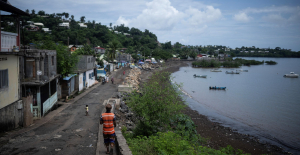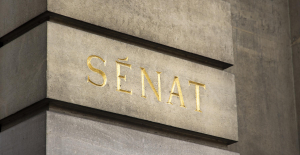The involvement of the Houthi rebels in the conflict between Israel and Hamas has reached a new level. In the first days following the October 7 attack, the Yemeni militia, backed by Iran and still at war with its country's government forces, was content to target southern Israel with drones. and missiles. These attacks were then presented as retaliation for the intense IDF bombings in the Gaza Strip. Since the middle of November, the Houthis have changed their method and considerably broadened the scope of their targets as well as the means used.
Now, the Shiite militia is targeting cargo ships transiting the Red Sea and the Bab el-Mandeb Strait, located between Yemen and Djibouti, endangering maritime traffic in this highly strategic area. It all started on November 19, when a Houthi commando boarded and stormed the commercial ship Galaxy Leader, which belongs to a British company. Since then, at least 18 other acts of piracy have been recorded as of December 18. The Yemeni rebels, who with Hamas and Hezbollah form the “axis of resistance” against the Hebrew state, are thus trying to make Western countries pay for their support of Israel.
Most of the Houthi drones or missiles fired at merchant ships were intercepted by Western warships positioned in the area. But some cargo ships were not so lucky. This Monday, December 18, the tanker M/V Swan Atlantic, flying the Norwegian flag, was attacked by “an unidentified object” coming from Yemen, according to its owner, Inventor Chemical Tankers. Friday, December 15, a container ship from the world leader in maritime transport MSC, the Palatium III, was hit by a ballistic missile attack claimed by the Houthis. A similar ship from the German shipowner Hapag-Lloyd, the Al Jasrah, was damaged the same day.
On Monday, December 11, the Norwegian-flagged chemical tanker Strinda was also hit by an anti-ship cruise missile, causing a fire on board. On November 26, the tanker Central Park, flying the Liberian flag, was boarded by Houthi pirates before the latter were arrested by the American navy.
As an immediate consequence of these incidents, the vast majority of maritime carriers chose to be cautious, temporarily abandoning the Red Sea and the Bab el-Mandeb Strait. This is notably the case of the Italian-Swiss MSC, the Danish Maersk, the German Hapag Lloyd and the French CMA CGM. Until further notice, the ships of these shipowners are forced to detour several thousand kilometers, via the Cape of Good Hope, in the south of Africa. Freight costs therefore jump mechanically, and travel time is extended by at least 10 to 15 days.
The Bab el-Mandeb Strait is one of the busiest in the world. 40% of maritime trade passes through this corridor, barely 30 kilometers wide, before taking the Suez Canal to reach the Mediterranean and therefore Europe. Around 20,000 ships loaded with manufactured products, but especially hydrocarbons, pass through this route each year. Since the Houthis began their attacks, the Western military presence has increased considerably in the area.
At the beginning of November, the American aircraft carrier USS Dwight D. Eisenhower crossed the Suez Canal to cruise in the waters of the Red Sea, accompanied by its escort, notably composed of the cruiser USS Philippine Sea and the destroyers USS Mason, USS Gravely and USS Carney. The latter shot down no less than 14 drones launched from areas of Yemen controlled by the Houthis on Saturday, December 16. The United Kingdom also sent the frigates HMS Lancaster and HMS Diamond and Spain, the frigate Victoria.
France, for its part, deployed the multi-mission frigate (FREMM) Languedoc. On December 10, the general staff indicated that this ship had shot down “two drones which were heading straight towards it from the coast of Yemen”. This is the first time that a French military building has been targeted by the Houthis since the start of the war between Israel and Hamas.
Traveling to Tel Aviv on December 17, Foreign Minister Catherine Colonna indicated that these attacks in the Red Sea “cannot go unanswered.” “We are studying several” defensive “options with our partners,” she said. During a trip to the Middle East this week, US Defense Secretary Lloyd Austin could also announce the formation of a coalition against the Houthis, to strengthen maritime security in the region, according to the specialist blog The War Zone.

 Chinese journalist released from prison four years after denouncing China's handling of Covid
Chinese journalist released from prison four years after denouncing China's handling of Covid “Russian law” adopted in Georgia: Europeans alongside the streets
“Russian law” adopted in Georgia: Europeans alongside the streets Germany: a new research operation will be launched for a 6-year-old autistic child
Germany: a new research operation will be launched for a 6-year-old autistic child Gaza: under the spotlight, the Israeli-Palestinian conflict shakes up the Eurovision contest
Gaza: under the spotlight, the Israeli-Palestinian conflict shakes up the Eurovision contest Inflation rises to 3.3% in April due to gas and food
Inflation rises to 3.3% in April due to gas and food “Mediterranean diet” or “DASH”, two good tips for eating better
“Mediterranean diet” or “DASH”, two good tips for eating better Fatal case of cholera in Mayotte: the epidemic is “contained”, assures the government
Fatal case of cholera in Mayotte: the epidemic is “contained”, assures the government The presence of blood in the urine, a warning sign of bladder cancer
The presence of blood in the urine, a warning sign of bladder cancer A Frenchman must reach space on Sunday with a Blue Origin rocket
A Frenchman must reach space on Sunday with a Blue Origin rocket Distributors obtain a small price increase from manufacturers
Distributors obtain a small price increase from manufacturers Cristaline water bottles “with the smell of hydrocarbons” recalled in Mayotte
Cristaline water bottles “with the smell of hydrocarbons” recalled in Mayotte 737 MAX: Boeing could face criminal charges for two accidents that left 346 dead
737 MAX: Boeing could face criminal charges for two accidents that left 346 dead The second act, The Palace, The Fantastic Three... Films to watch this week
The second act, The Palace, The Fantastic Three... Films to watch this week The tears of Meryl Streep, the show of Zaho de Sagazan and Greta Gerwig... Cannes plays the “girl-power” card
The tears of Meryl Streep, the show of Zaho de Sagazan and Greta Gerwig... Cannes plays the “girl-power” card A demonstration with Judith Godrèche demands the departure of the director of the CNC
A demonstration with Judith Godrèche demands the departure of the director of the CNC An Avignon Off Festival under the sign of peace
An Avignon Off Festival under the sign of peace Omoda 7, another Chinese car that could be manufactured in Spain
Omoda 7, another Chinese car that could be manufactured in Spain BYD chooses CA Auto Bank as financial partner in Spain
BYD chooses CA Auto Bank as financial partner in Spain Tesla and Baidu sign key agreement to boost development of autonomous driving
Tesla and Baidu sign key agreement to boost development of autonomous driving Skoda Kodiaq 2024: a 'beast' plug-in hybrid SUV
Skoda Kodiaq 2024: a 'beast' plug-in hybrid SUV The home mortgage firm rises 3.8% in February and the average interest moderates to 3.33%
The home mortgage firm rises 3.8% in February and the average interest moderates to 3.33% This is how housing prices have changed in Spain in the last decade
This is how housing prices have changed in Spain in the last decade The home mortgage firm drops 10% in January and interest soars to 3.46%
The home mortgage firm drops 10% in January and interest soars to 3.46% The jewel of the Rocío de Nagüeles urbanization: a dream villa in Marbella
The jewel of the Rocío de Nagüeles urbanization: a dream villa in Marbella Europeans: professor threatened with death Didier Lemaire shows his support for François-Xavier Bellamy
Europeans: professor threatened with death Didier Lemaire shows his support for François-Xavier Bellamy LFI: Manon Aubry places social issues at the center of her European campaign
LFI: Manon Aubry places social issues at the center of her European campaign Diving into the secrets of the National Assembly
Diving into the secrets of the National Assembly Institutions: senators want to restore the accumulation of mandates and put an end to the automatic presence of ex-presidents on the Constitutional Council
Institutions: senators want to restore the accumulation of mandates and put an end to the automatic presence of ex-presidents on the Constitutional Council These French cities that will boycott the World Cup in Qatar
These French cities that will boycott the World Cup in Qatar Top 14: “We have to take them out”, Franck Azéma’s rant against certain USAP supporters
Top 14: “We have to take them out”, Franck Azéma’s rant against certain USAP supporters Paris 2024 Olympic Games: route, timetables and torchbearers... Where to see the Olympic flame this Wednesday, May 15?
Paris 2024 Olympic Games: route, timetables and torchbearers... Where to see the Olympic flame this Wednesday, May 15? Tour of Italy: scare when a dog bursts onto the road in front of the peloton
Tour of Italy: scare when a dog bursts onto the road in front of the peloton Michael Schumacher: some of his watches sold for nearly 4 million Swiss francs
Michael Schumacher: some of his watches sold for nearly 4 million Swiss francs


















